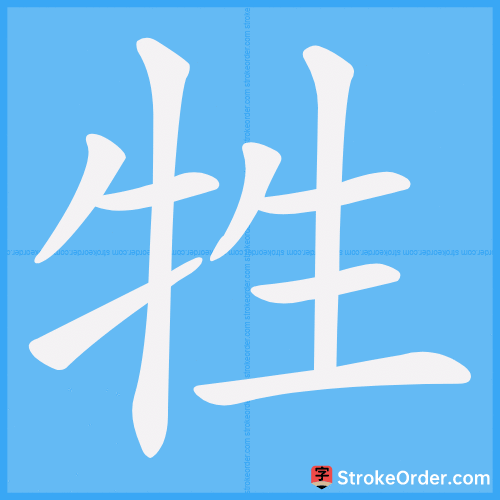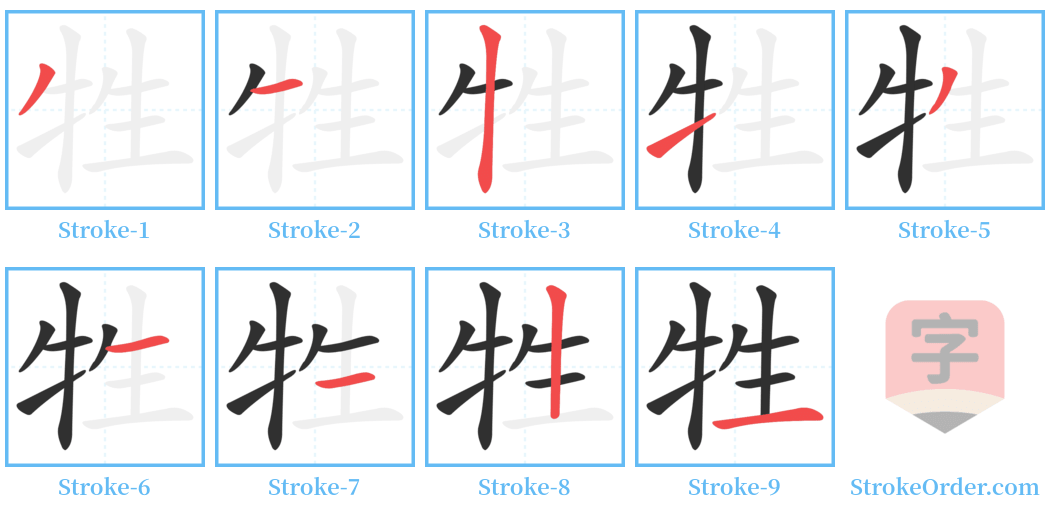牲 Stroke Order
Animated Stroke Order of 牲

Stroke Order Diagrams for 牲

Step-by-Step Handwriting Guide for 牲

Learn to Write Chinese Characters with Video Tutorials
Watch the video of writing the Chinese character "牲", learn the correct stroke order (笔顺) of the character "牲", and master the standard way of writing the character "牲".
Free Printable Handwriting Practice with Stroke Order: 牲
Printable Writing Practice Worksheet of "牲" in Portrait Orientation (Tian Zi Ge)

Printable Writing Practice Worksheet of "牲" in Landscape Orientation (Tian Zi Ge)

Information of 牲
Pinyin
shēng
Radical
牜
Strokes
9 strokes
Usage
★★★★★
Definition
domestic animal
牲 [shēng]
名词
【本义】: 古代供祭祀用的全牛
(Original meaning: A whole cow used for sacrificial offering in ancient times.)
【造字法】: 形声。从牛,从生
(Character formation: A phonetic compound, incorporating the character for cow and the character for life.)
1. 同本义 (Cattle sacrifice)
2. 泛指供祭祀、盟誓及食用的家畜,包括牛、羊、豕、马、犬、鸡等
(A general term for livestock used for sacrifices, oaths, and food, including cattle, sheep, pigs, horses, dogs, and chickens.)
- 引用: 《周礼·牧人》:掌牧六牲。
(Zhou Rituals: The herdsman oversees the six livestock.)
- 例: 牲犊 (A young cow offered to the emperor by vassals); 牲饩 (Living animals offered as gifts); 牲醪 (Sacrificial meat); 牲头 (Head of the sacrificed animal); 牲糈 (Sacrificial livestock and fine rice); 牲币 (Animal sacrifices and silk); 牲号 (The name of the sacrifice.)
3. 指野生动物 (Wild animal)
- 引用: 《左传·昭公二十五年》:是故为礼以奉之:为六畜、五牲、三牺,以奉五味。
(Zuo Zhuan: Therefore, offerings are made in ritual to honor it: including six livestock, five animals, and three sacrifices, to provide the five flavors.)
4. 通“腥”。生的肉食 (Flesh)
- 引用: 《周礼·掌客》:凡诸侯之礼,上公五积…鼎簋十有二,牲三十有六,皆陈。
(Zhou Rituals: All the rituals of the feudal lords are to be composed… twelve tripod vessels and thirty-six animal sacrifices, all presented.)
livestock, or specifically the six farm animals cow, horse, sheep, cock, dog, pig 牛馬羊雞狗豬|牛马羊鸡狗猪 / an insult, You animal!
Input Method for 牲
Pinyin
sheng1
Wubi
trtg|ctgg
Cangjie
hqhqm
Zhengma
mbmc
Four Corner
25510
Unicode
U+7272
Same Pronunciation Characters